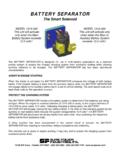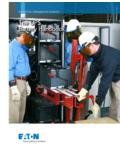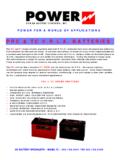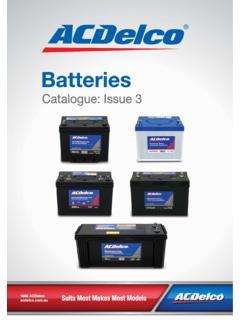Transcription of AUTOMOTIVE BATTERY TRAINING MANUAL FLOODED …
1 AUTOMOTIVE BATTERY TRAINING MANUAL FLOODED BATTERIESCERTTUVISO 14001: 2004 ISO 9001: 2000 ISO/TS 16949 PageSAFETY PRECAUTIONS 1 HOW A BATTERY WORKS 2 BATTERY CONSTRUCTION 3 BATTERY RATINGS 5 EFFECTS DURING DISCHARGE 6 EFFECTS DURING CHARGING 7 BATTERY CARE AND MAINTENANCE 8 COMMON BATTERY CAUSES OF FAILURE 9 NEW BATTERY INSTALLATION 10 TESTING 11 CLAIMS ADJUDICATION PROCEDURES 12 WARRANTY ASSESSMENT WITHOUT 'SMART TESTER 14 BACK TO BATTERY BASICS - THE POWER TEAM 16 SULPHURIC ACID 17 LEISURE BATTERY RANGE 18 TWIN BATTERY SETUPS 19 JUMP STARTING 21 WARRANTY & CLAIMS DOCUMENTATION PROCEDURE 21 STARTER BATTERY WARRANTY 22 LEISURE BATTERY WARRANTY 23 SMF 100/101 BATTERY WARRANTY 24 MOTORCYCLE BATTERY WARRANTY 25 The
2 Wording, artwork and trade marks used herein are the subjects of statutory protection including copyright in the name of First National BATTERY Company, Division of Metindustrial (Pty) Ltd. All rights herein are reserved and no part of this AUTOMOTIVE BATTERY TRAINING MANUAL may be reproduced or transmitted in any form or by any means howsoever and whether electronically or mechanically and including photocopying, recording or by any information storage or retrieval system, without the prior written permission from First National BATTERY Company, Division of Metindustrial (Pty) information appearing in this AUTOMOTIVE BATTERY TRAINING MANUAL is intended to be of a general nature only and whilst every effort has been made to include accurate and current information, errors can occur. The information herein contained is intended as a guide only and relevant professional advice must be taken should a definitive analysis of any particular problem be required.
3 First National BATTERY Company, Division of Metindustrial (Pty) Ltd. accordingly disclaims any responsibility / liability for any loss, damage, injury or expense howsoever arising out of or in connection with the use of or the reliance upon the information so provided or the omission thereof and/or any errors herein contained. Please note that certain brands of products as identified herein may only be available for supply in certain territories in the sole discretion of First National BATTERY Company, Division of Metindustrial (Pty) acknowledge with thanks the use of certain BCI PRECAUTIONSB atteries contain dilute sulphuric acid. They also emit hydrogen gas which can produce an explosive mixture. Therefore this first section of the MANUAL deals with safety precautions to be followed when working with batteries.
4 Specific safety precautions will be mentioned throughout the MANUAL where BATTERY ACIDWhen working with acid wear a face shield and protective extreme care to avoid spillage or splashing as it can destroy clothing and if not treated promptly cause damage to the skin. Be especially cautious when lifting batteries with polypropylene containers as pressure on the end walls could result in acid being ejected through the vent plugs. If acid is spilt onto clothing or the skin it should be neutralised immediately using a solution of baking soda or household ammonia and water and then rinsed using clean acid enters the eye, force the eye open and flood with cool, clean water for approximately fifteen minutes. If acid is swallowed drink large quantities of water or milk. Follow with milk of magnesia. Obtain medical advice as soon as possible.
5 Do not encourage spilt on the surface of the car should be neutralised and rinsed with clean water. We do not recommend the dilution of concentrated sulphuric acid by non-qualified personnel. In any event, batteries are supplied in a filled and charged condition and should never require acid to be added except in the case of spillage. Under such circumstances advice should be sought from the BATTERY OF EXPLOSIONSBATTERIES PRODUCE EXPLOSIVE GASES. KEEP SPARKS, FLAMES, BURNING CIGARETTES OR OTHER IGNITION SOURCES AWAY FROM THE BATTERY AT ALL TIMES. ALWAYS WEAR SAFETY GOGGLES OR A FACE SHIELD WHEN WORKING NEAR allow trained personnel to work on a BATTERY . They should know and observe the safety precautions detailed in this MANUAL . They should be familiar with the procedures to be followed if they attempt to charge or test a BATTERY or jump start a vehicle.
6 The manufacturer s instructions must be followed when any equipment such as a charger or tester is used. Hydrogen and oxygen are produced as a part of the operation of the BATTERY . These gases produce an explosive mixture within the BATTERY and escape through the vents. Many modern batteries incorporate a flame arrester but it is still essential to keep any form of ignition well away from the BATTERY . An exploding BATTERY can cause severe injury from flying pieces of container and acid. Always wear safety goggles or a face shield when working near a BATTERY . Avoid leaning over the BATTERY when charging, testing, jump starting , connecting or disconnecting. Do not break live circuits at the terminals of the BATTERY as this invariably causes a spark to be produced at the point where the circuit is broken. Ensure that the charger cable clamps or jump start leads are in good order and the connections are good.
7 A poor connection can cause an electrical arc which can ignite the hydrogen gas and cause an dropping tools across the terminals and use insulated spanners. Do not smoke or bring any naked flame near the A BATTERYThe BATTERY should be charged in a well ventilated area. Do not remove the vent plugs during charge except when taking readings of specific gravity or topping up, if the charger manufacturer s sure that the charger is switched off before connecting to the BATTERY . Connect the charger leads to the BATTERY terminals with the red positive (+) lead to the positive terminal and the black or blue negative (-) lead to the negative terminal. The BATTERY should not be charged whilst still connected to the 2vehicle as the voltages reached during charge can damage the vehicle s electrical touch the charger leads while the charger is switched on.
8 This could break the circuit creating a spark which could result in an STARTING AN ENGINE (Refer to page 16)Each step in the procedure Jump Starting as described on page 16 must be followed carefully. Failure to do so could result in a) acid damage due to gushing of electrolyte through the vents, b) explosion of one of the batteries or c) damage to the electrical system of one or both A BATTERY WORKSWhen two dissimilar conducting materials (electrodes) are immersed in a solution capable of conducting electricity (an electrolyte) one will become positively charged and the other negatively. The ends of the electrodes protruding above the electrolyte are known as the positive and negative terminals and the whole unit is called a cell. Connecting the terminals with a wire will cause an electrical current to flow through the wire from the negative to the positive potential difference or electrical pressure between the terminals is dependent upon the materials of the electrodes and the electyrolyte and is measured in CELLSIn a torch BATTERY the electrodes comprise the positive carbon rod in the centre of the cell and the negative zinc container with a jelly electrolyte of ammonium chloride.
9 The potential of the cell is approximately volts. During use the zinc is slowly dissolved in the production of the current, and when it or the ammonium chloride is exhausted, the flow of current ceases and the cell must be discarded. Such cells are termed primary or CELLSThe lead acid cell belongs to the group termed secondary or re-chargeable. Here the electrodes are a lead dioxide positive, and a sponge lead negative with a dilute sulphuric acid electrolyte. During discharge current flows and positive and negative electrodes convert to lead sulphate and absorb sulphate ions from the electrolyte reducing it to water. Unlike the torch cell, the lead-acid cell is reversible and may be restored to its original condition by passing electricity through the cell in the opposite direction from which it was removed.
10 This reverses the reactions in the cell, converting the lead sulphate in the plates back into their original active materials and returning the sulphate ions to the acid cells have a potential of approximately 2 volts irrespective of size. Larger cells will have a higher capacity and deliver the same current for longer or higher current for the same period than smaller cells. Cells may be connected in series ( the negative of one cell to the positive of the next) to give higher voltages. Thus three cells connected in series will give a BATTERY of cells having a nominal voltage of 6 volts. Similarly six cells connected in series will produce a 12 volt OF THE BATTERYThe three main functions of the AUTOMOTIVE BATTERY are to:1) Supply power to the starter and ignition system so that the engine can be cranked and ) Supplement the electrical load when load requirements exceed the supply capability of the alternator.












